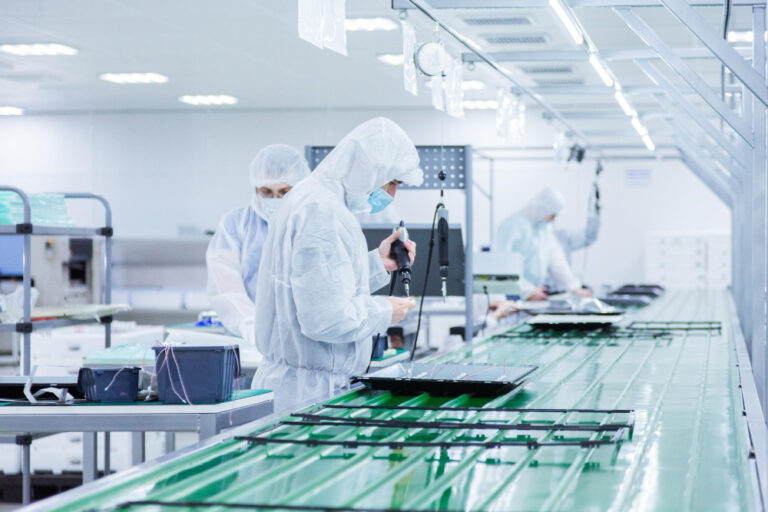Small Pixel LED displays largely depend on COB and SMD manufacturing technologies. Today, we will talk about the difference between COB and SMD LED technology.
Table of Contents
Manufacturing process
SMD technology
SMD packaging uses individual LED chips into beads that are then soldered to a PCB to form LED modules. These LED modules are eventually assembled into a complete LED screen.
COB technology
In contrast, COB technology directly welds the light-emitting chip to the PCB and then performs overall coating to form a unit module. The modules are then assembled into seamless LED screens.
Product differences
Picture quality
The light emitted by SMD LED displays from individual chips creates a point-light effect. The COB LED display is integrally coated on top of the LED chip to convert the light source into surface light. The latter provides superior overall visual perception, minimizing the grainy appearance of point lights. COB LED displays are particularly suitable for long-term close viewing because they reduce eye fatigue and provide a more aesthetically pleasing experience.
In terms of contrast, COB LED screens benefit from advanced packaging and can achieve over 20,000:1 contrast ratio instead of the 10,000:1 limit of SMD LED displays. This results in a viewing experience closer to that of a liquid crystal display (LCD), with vibrant colors and enhanced detail.
However, COB LED displays lack the ability to individually calibrate light-emitting chips as SMD LED displays. This can cause color inconsistencies when viewed from a wide angle.
Reliability
SMD LED screens adopt chip-first packaging, which has weak overall protection capabilities. They are easily damaged and have poor waterproof, moisture-proof, and dust-proof capabilities. While they are easily repairable in the field, they are also simpler to maintain.
COB LED screen adopts direct chip and overall coating method, with excellent overall protection performance, and the front protection level reaches IP65. They are water, moisture, and impact-resistant and can be easily cleaned with a damp cloth. However, due to the integral coating, on-site repair is impractical and requires specialized equipment, making it inconvenient.
Energy efficiency
SMD LED screens typically feature front-mounted LED chips with obstructive leads, which will produce higher power consumption. COB LED screens use inverted chip technology to provide an unobstructed light source, thereby reducing power consumption at the same brightness level. This feature helps improve energy efficiency and economic viability.
Cost difference
SMD technology: The production process of SMD LED displays is relatively complex, but the technical threshold is low. The market has thousands of manufacturers, fierce competition, and mature technology.
COB technology: The technical barriers to COB production technology are relatively high, and there are less than 20 capable manufacturers in the country. Although the cost is lower in theory, the production yield is lower, putting COB LED displays at a cost disadvantage. The cost difference is at least 1.2 times that of SMD LED displays.
LED leading manufacturers discuss COB technology
Voury:
They think MIP is a technical idea that is broken down into parts. The priority is to separate and then solder to the PCB, which is more separate than the SMD technology route. The advantage of this route is that the chip is smaller, and the loss is lower. It has the opportunity to reduce costs.
In essence, it does not leave the SMD technology route; the COB route is integrated, and the advantage of simplifying the integrated route is that it can make the product more stable, have a wider color gamut, be more energy-saving, and be more environmentally friendly. Based on the needs of chip optimization and later correction, the cost is not as good as the MIP route.
Absen:
MIP (Mini LED in Package) and COB are mainly used in large-size displays and play an important role in indoor LED display scenarios. They are suitable for control rooms, large conference rooms, exhibition displays, and some high-end residential and other large-screen application scenarios. The main direction of traditional screen companies.
IAMLEDWALL:
From a cost perspective, COB technology is evenly matched with SMD Packaging in the P1.2 LED display. By using a P0.9 LED display, the comprehensive application cost of COB has obvious advantages over SMD.
From a manufacturing perspective, COB is an integrated packaging display technology. It will reduce some manufacturing links and achieve higher production efficiency.
In conclusion
As an industry-leading used LED display provider, IAMLEDWALL provides a full range of SMD and COB display products with strong R&D, production, delivery, and after-sales service capabilities.
LED display technology continues to shape the market, with COB and SMD technologies each offering unique advantages and considerations. IAMLEDWALL’s commitment to innovation ensures customers receive cutting-edge solutions tailored to their specific needs, ensuring advanced display technologies are seamlessly integrated into a variety of applications.

